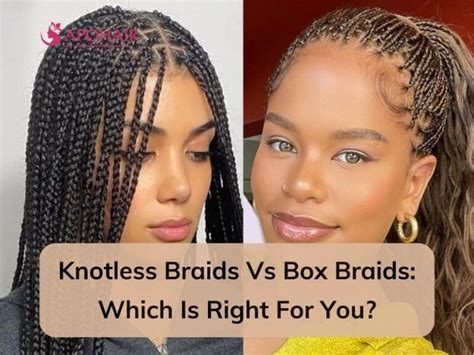Introduction
Choosing between knotless and box braids can be a daunting task, especially with so many factors to consider. This comprehensive guide will delve into the key differences between these two popular braiding techniques, empowering you to make an informed decision that aligns with your unique preferences and hair needs.

Knotless Braids: A Gentle Touch
Knotless braids, as the name suggests, are installed without any knots at the root. Instead, they utilize a “feed-in” method, where hair extensions are added as you braid. This eliminates tension and stress on the scalp, making knotless braids a gentler option for those with sensitive scalps or fragile hair.
Benefits of Knotless Braids:
- Reduced scalp tension and discomfort
- Promotes hair growth and reduces breakage
- Offers a more natural and seamless appearance
- Allows for greater versatility in styling
Considerations for Knotless Braids:
- Requires more time to install than box braids
- Can be slightly more expensive than box braids
- May be more prone to frizz if not properly maintained
Box Braids: Timeless Tradition
Box braids, a longstanding braiding tradition, are created by dividing hair into square or rectangular sections and braiding each section separately. They offer a bold and striking look and can provide excellent protection for natural hair.
Benefits of Box Braids:
- Easy to maintain and style
- Offer excellent hair protection
- Available in a wide range of sizes and colors
- Can last for several weeks with proper care
Considerations for Box Braids:
- Can be heavy and put tension on the scalp
- May cause breakage if installed too tightly
- Can be difficult to remove, requiring professional assistance
Comparison Table: Knotless vs. Box Braids
| Feature | Knotless Braids | Box Braids |
|---|---|---|
| Root Installation | Feed-in, no knots | Individual sections, knots at the root |
| Scalp Tension | Low | Medium to high |
| Hair Protection | Moderate | High |
| Versatility | High | Moderate |
| Maintenance | Moderate | Low |
Which Braiding Technique is Right for You?
The best braiding technique for you depends on your individual preferences, hair type, and lifestyle.
Knotless braids are recommended for:
- Individuals with sensitive scalps or fragile hair
- Those who prioritize hair growth and reduced breakage
- People who prefer a more natural and versatile look
Box braids are preferred by:
- Individuals who desire easy maintenance and styling
- People who need maximum hair protection
- Those who favor a bold and striking appearance
Conclusion
Whether you choose knotless or box braids, both techniques offer unique advantages and considerations. By understanding the key differences between them and considering your individual needs, you can make an informed decision that will enhance your hair goals and personal style.
Emergent Trends in Hair Extensions
The hair extension industry is constantly evolving, introducing innovative techniques and materials to enhance the versatility and appeal of hair extensions.
Micro Link Extensions
Micro link extensions utilize tiny metal beads to attach hair extensions to natural hair. They offer a seamless and natural look with minimal damage to existing strands.
Tape-In Extensions
As the name suggests, tape-in extensions are attached to natural hair using thin, adhesive tapes. They provide a quick and affordable method for adding volume and length.
Fusion Extensions
Fusion extensions involve bonding hair extensions to natural hair using heat-activated keratin or polymer tips. They offer long-lasting results but require professional installation and maintenance.
New Horizons in Innovation
Beyond these existing techniques, the industry is also exploring new and groundbreaking advancements:
- Magnetic Clip-in Extensions: Magnetic clip-in extensions use magnets to attach to natural hair, allowing for easy and damage-free installation and removal.
- 3D Printed Hair: 3D printing technology is being used to create custom-made hair extensions that match the exact texture and color of natural hair.
- Biodegradable Extensions: Sustainable hair extensions made from biodegradable materials are gaining popularity, addressing environmental concerns.
Future Possibilities
The future of hair extensions holds endless possibilities:
- Personalized Extensions: AI-powered technology could analyze hair samples and create personalized hair extensions tailored to individual needs.
- Self-Styling Extensions: Extensions that can be styled using heat or cold without damaging the hair, empowering users with greater styling freedom.
- Smart Extensions: Extensions equipped with sensors that monitor hair health and alert users to potential issues, promoting preventive care.
Conclusion
The hair extension industry is brimming with innovation, continuously pushing boundaries to enhance the beauty, versatility, and health of hair. As technology advances, we can anticipate even more groundbreaking advancements that will revolutionize the way we wear and care for our hair.
